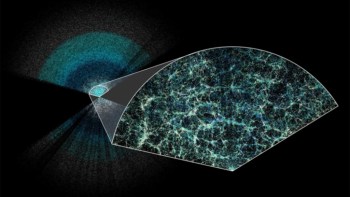
A slight difference in the sounds created by neutrons and alpha particles as they travel through a liquid could lead to the first direct detection of dark matter, say physicists working on the PICASSO experiment at SNOLAB in Canada.
Dark matter is thought to constitute up to 95% of all matter in the universe, but has never been observed directly. Our own Milky Way galaxy is thought to have a dark matter halo, through which Earth is moving and therefore it may be possible for us to detect the stuff.
Some physicists believe that dark matter could take the form of weakly interacting massive particles (WIMPs), which interact with normal matter via the weak force. However, such interactions are expected to be exceedingly rare and therefore any successful dark-matter detector must be able to differentiate between a rare WIMP interaction and background noise.
Buried deep underground in a former mine to shield it from cosmic rays, PICASSO is a bubble chamber containing 80 g of C4F10 fluid that is superheated above its boiling point. It detects subatomic particles via the bubbles they create when they collide with a nucleus in the fluid. Bubble creation is detected through the sound waves that are created when a bubble forms.
Noisy contaminants
Most of the background noise in PICASSO comes from alpha particles that are given off by radioactive contaminants in the detector. As a result, it is crucial that the PICASSO team work out a way to tell the difference between WIMPs and alpha particles.
A ready source of WIMPs is of course not available, so the team used a source of neutrons instead. Like WIMPs, neutrons have no electrical charge and therefore have a low probability of colliding with a nucleus — although nowhere near as low as WIMPs. By contrast, alpha particles have an electrical charge and therefore are more likely to interact with nuclei (and electrons) in the fluid.
The team studied the acoustic signals produced when the detector was exposed to neutrons and then to alpha particles. They found that the neutrons produced significantly quieter sounds than alpha particles — and that this difference is large enough to distinguish between the different particles (New J. Phys. 10 103017).
According to PICASSO spokesperson Viktor Zacek of the University of Montreal, the team stumbled upon the idea while calibrating the response of the detector using neutrons and compared the acoustic signals to alpha-particle data. The difference was first interpreted as a fault in the detector. “However, when we checked the data and refined the analysis the discrimination effect became even more pronounced,” he explained.
Multiple bubbles
The team doesn’t fully understand why the alpha particles are “louder” than the neutrons, but believes it could be related to the fact that they tend to create multiple bubbles in a collision, whereas the neutrons tend to only create a single bubble.
As well as helping in the quest for dark matter, the team also believes that its discovery could lead to better detection of alpha-particle emitting nuclei in biological materials and boost the sensitivity of neutron detectors.



